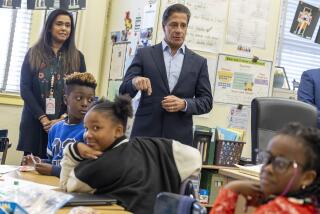Year-Round Schooling
- Share via
Under the category of Our Changing Times, we may soon be witnessing the beginning of the end of the traditional September-June public school year and the three-month summer vacation. Already, more than 400 schools around the nation have joined the growing movement to year-round education, including 48 in San Diego County.
In a year-round school, students attend classes in nine-week segments followed by a three-week vacation. The San Diego Unified School District already has nearly two dozen schools operating on this calendar, and six other school districts in the county have year-round schools. But attending those schools is not mandatory. Under San Diego’s “Long Range Facilities Master Plan” adopted last week, however, a student assigned to a year-round school would have to go there unless he or she qualifies for and chooses to instead attend a magnet school.
The movement toward changing the school calendar is propelled by two factors, one economic, the other philosophical. In many states, including California, the student population is increasing rapidly at the same time there is less money available to build new classrooms. This was the compelling factor in the San Diego board’s decision to implement multitrack, year-round calendars on a mandatory basis beginning with Jerabek Elementary this July. In these schools, there would be four “tracks” of students and teachers, and one track would always be on its three-week vacation.
The other reason year-round schools are gaining in popularity is that educators think students learn better when they don’t have such a long hiatus between school sessions. At the elementary level, the review period that begins each year can be shortened from a month to a few days.
Districts with year-round classes report less teacher burnout and say that nine weeks of school is about the time it takes for students to begin getting restless. After the three-week break, the youngsters return to class refreshed.
For now, the multitrack, year-round calendar will mainly be limited to elementary schools. It’s more difficult to work out the course offerings for a high school on that system, but it is being done in Los Angeles and a few other cities. San Diego Supt. Thomas W. Payzant believes that by the 1988-89 school year as many as 20 schools could be following the new calendar.
U.S. Secretary of Education William J. Bennett wrote in his new book, “First Lessons,” that though year-round schools “may require a rethinking of how we plan our vacations, that’s a reasonable price to pay for the promise of more successful lives for our children.”
In San Diego, it’s going to be a necessary price to pay as long as the student population continues to grow faster than schools can be built.
More to Read
Sign up for Essential California
The most important California stories and recommendations in your inbox every morning.
You may occasionally receive promotional content from the Los Angeles Times.













